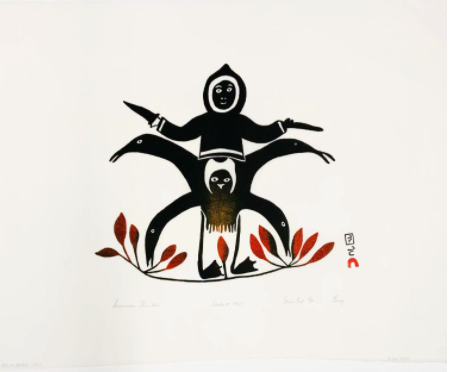
Summer Hunter - Lucy Qinnuayuak
The last seasonal days of summer are here, and so is SMCMoA’s final fold of Passage of Summer: A four-fold seasonal storytelling of selected works from the Collection. In August, Fold II visited the practices and history of the Cape Dorset Inuit art community through the print Birds of Summer by Pitseolak Ashoona. This final fold revisits artwork made in the community, exploring the stonecut print Summer Hunter created by Lucy Qinnuayuak (1915-1982) in 1969.
Lucy was born in Salluit, Northern Quebec in 1915. As a young child with her mother and sister, she journeyed to Baffin Island, North West Territories, where they cycled through several outpost camps. Lucy began to draw in her thirties while living at the Supujauk camp. During resupply trips to Kinngait, she would take these drawings to James Houston, a government stationed artist and graphic designer, who would appraise her work. Lucy moved to Kinngait as her interest in graphic arts expanded. In Kinngait, she joined the printmaking program, becoming one of the first graphic artists to create works through the Kinngait Studios. The featured stonecut, Summer Hunter, exemplifies Lucy’s earlier artistic style. Over time her work shifted away from stonecuts, and in the 1970s, she started experimenting with acrylics and mixed media.
Lucy’s work is most recognizable through her depictions of birds. She drew variety of birds in various poses, usually juxtaposing the creatures intertwined with human characteristics. In Summer Hunter, the bird-like figures are depicted within the physical shape and placement in the human form. The central top figure stands above four extended animal forms and one centered form. This top figure stands with arms outstretched, holding what appears to be a knife in one hand and a shiv in the other. The forms are reduced, as Lucy used the black and white contrast of the print to draw attention to the eyes and outlined silhouettes of the figures. Summer Hunter, as typical with her earlier work, depicts gulls and geese, defined by bold outlines of the necks extending out. Over time, owls became a common motif in her work; the densely covered plumage depicted through colorful patterns and designs.
Like Pitseolak Ashoona’s work, Lucy’s artwork invites the viewer into the artist’s inner world and outward interpretations of life experiences. The depictions call upon the region’s harsh and remote environment, highlighting elements and stories of everyday traditional camp activities and gatherings. The subjects indicate the daily themes and ways women in traditional Inuit culture navigated their roles for survival. Lucy combines visual elements speaking to hunting and gathering, exploring the relationship and meaning of birds and wild animals, and the physical necessity of tools and objects needed to fulfill life dependent tasks.
Lucy’s prints have been collected and exhibited across Canada and internationally. In 1976, one of her designs was selected to cover the Olympic banner. SMCMoA is fortunate to house and care for Lucy’s work and prints by her niece, Kenojuak Ashevak.
Sources:
“Lucy Qinnuauyuak”. Inuit Art Quarterly. Inuit Art Foundation. Accessed July 17, 2020.
"Qinnuayuak, Lucy". Canadian Women Artists History Initiative. July 11, 2012. Accessed July 15, 2020.
Eber, Dorothy Harley, "Lucy Qinnuayuak". July 2, 2006. The Canadian Encyclopedia. Historica Canada. Accessed July 15, 2020.